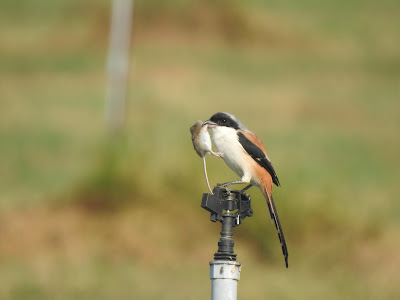 |
| An Oriental Pratincole, a summer migrant that breeds in Shalun |
Shalun is an awesome birding spot that’s quite near the edge of Tainan city and right by the High-Speed Rail Station. You can easily see easily see the otherwise rare Ring-necked Pheasant and the locally common Barred Buttonquail. The area was formerly all sugar cane fields owned by the Taiwan Sugar Corporation. Over time, they sold off most of the land for development, and now there are many fancy high-rise apartment buildings, an outlet mall, and lots of new developments and parking structures … and not a sugarcane field in sight.
 |
| A Lesser Coucal |
Shalun is one of the last remaining grasslands in the Tainan area. It has a very diverse habitat, with grassland, farmland, a small creek, a bamboo forest, and a broadleaf forest. Thus, there are lots of different birds to be found, including skylarks, pipits, shrikes, starlings, Black-winged Kites, Oriental Pratincoles in the summer, and of course, the famous Ring-necked Pheasant. It is also a very important habitat for the critically endangered Australasian Grass-owl. In the bamboo forest, you can often see Vinous-throated Parrotbills, Red-capped Babblers, Taiwan Scimitar-babblers, Lesser Coucals, and of course the common bulbuls, egrets, and herons.
 |
| A Black-winged Kite, hovering over a potential meal |
What I really like about Shalun is that it always offers a big list, a large range of different bird species, and is always a good place to knock off a few year listers. Although you don’t always see lifers there, you can see some interesting bird behaviors … it can sometimes be like a live version of National Geographic. I once saw a Long-tailed Shrike capture and eat a long-tailed shrew on top of a sprinkler.
 |
| A Long-tailed Shrike and an unfortunate shrew |
Sadly, the Shalun area is under constant threat of overdevelopment. This is bad news for birders and birds alike, especially the endangered grass-owl. I really hope the Tainan government will do something to balance development with ecological preservation, and leave birds a safe place to live.
 |
| An Oriental Skylark |
~Article and Photos by Isaac Lang
Comments
Post a Comment